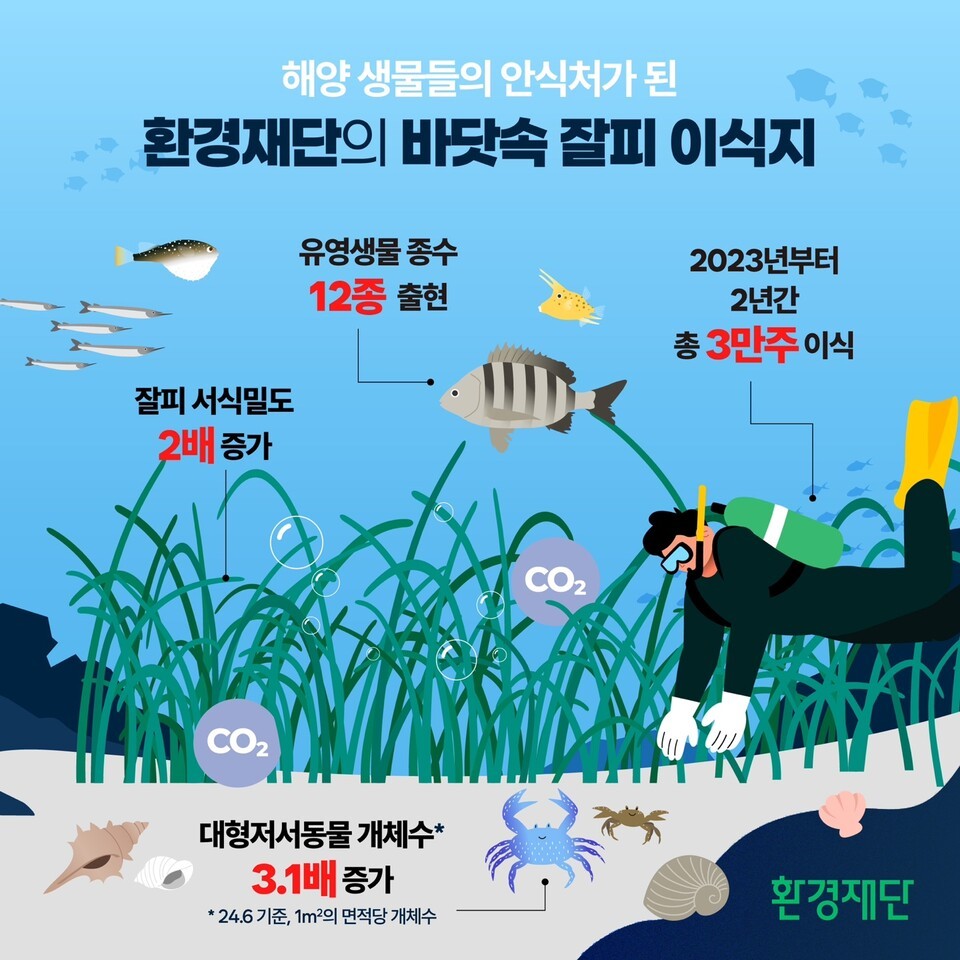Seagrass is emerging as a practical solution for carbon absorption and marine ecosystem restoration. It has been confirmed that seagrass, recognized as a carbon sink by the Intergovernmental Panel on Climate Change (IPCC), plays a crucial role in enhancing biodiversity along the Korean coast.
The Korea Fisheries Resources Agency’s Namhae Headquarters and the Environmental Foundation announced that their “2023-2024 Seagrass Planting Biodiversity Study” has demonstrated seagrass’s contribution to marine ecosystem recovery. The study showed that seagrass beds provide stable habitats and spawning grounds for marine life, and supply abundant food sources and oxygen, thereby enhancing biodiversity.

The Environmental Foundation and Korea Fisheries Resources Agency collaborated with companies such as Shinhan Investment Corp and Lotte Chilsung Beverage to plant a total of 30,000 seagrass plants along the domestic coast. With funds from Shinhan Investment Corp’s social contribution fund, 20,000 plants were transplanted onto a 548㎡ area in Hwasam-ri, Yongnam-myeon, Tongyeong City, and 10,000 plants onto a 500㎡ area in Uihang-ri, Taean County, with Lotte Chilsung Beverage. The study found that transplanted seagrass facilitated the restoration of marine ecosystems by expanding their habitat.
In Tongyeong’s Seonchon Village Marine Protected Area, the seagrass habitat area increased by 548㎡ within a year, and in Uihang-ri, Taean, the habitat was stably established. In Tongyeong, the density of seagrass increased from 52 individuals per square meter to 111, approximately doubling the housing environment’s stability. Additionally, the number of fish species present increased from five before transplantation to twelve, a 2.4-fold increase, and the number of large benthos creatures from 518 individuals per square meter to 1,625, a 3.1-fold increase. In the study area, new species such as black bream, mackerel, and porcupinefish appeared, while arthropods like the spotted blue swimming crab and blue crab also established themselves.
Professor Kim Jongseong from Seoul National University’s Department of Earth and Environmental Sciences stated, “Restoring seagrass habitats holds significant meaning as it increases natural carbon sinks in response to climate change.” He explained, “Through the preservation and restoration of blue carbon habitats like seagrass, we can expect improvements in biodiversity recovery, ecosystem regulation, and disaster prevention, improving overall marine ecosystem services.”
Seagrass is recognized by the IPCC as ‘Blue Carbon,’ possessing a carbon absorption capability up to five times higher than tropical rainforests, making it a key element for carbon neutrality. Additionally, it is being spotlighted as a nature-based solution for restoring marine ecosystems and responding to climate change.
Seagrass alleviates the ‘green tides’ phenomenon, known as the desertification of the sea, and helps solve marine plastic problems. Research indicates that naturally fallen leaves from seagrass capture and aggregate microplastic fibers floating in the sea, pushing them ashore, which aids in maintaining the health of coastal ecosystems.
The Environmental Foundation declared, “Creating seagrass beds is a practical solution to climate change and marine ecosystem restoration.” The foundation emphasized plans to continuously expand efforts through public and private partnerships and various collaborations. Additionally, by increasing carbon sinks through seagrass, they plan to support the collection and disposal of marine debris within habitats, continuing sustainable environmental preservation activities to create a healthy marine ecosystem.
As seagrass bed restoration gains traction as a practical alternative for carbon neutrality and marine ecosystem protection, the collaboration of corporations, local governments, and civil society becomes increasingly important. Further research and policy support in the future are anticipated to influence the preservation of blue carbon ecosystems, including seagrass.